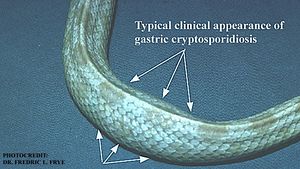Difference between revisions of "Snake Cryptosporidiosis"
| Line 1: | Line 1: | ||
{{review}} | {{review}} | ||
| − | [[Image:Crypto_lump_copy.jpg| | + | [[Image:Crypto_lump_copy.jpg|100px|thumb|right|'''Mid-body swelling''' © RVC]] |
[[Cryptosporidium|''Cryptosporidium'']] spp. are [[Protozoa|protozoa]] of the phylum Apicomplexa and commonly cause gastrointestinal disease in animals. ''Cryptosporidium serpentis'' infection in snakes causes gastric hypertrophy and consequent clinical signs. The mode of transmission is oral-faecal. The disease can either be subclinical with intermittent shedding or clinical with gastrointestinal disease. Non-ophidian reptiles may also be carriers. | [[Cryptosporidium|''Cryptosporidium'']] spp. are [[Protozoa|protozoa]] of the phylum Apicomplexa and commonly cause gastrointestinal disease in animals. ''Cryptosporidium serpentis'' infection in snakes causes gastric hypertrophy and consequent clinical signs. The mode of transmission is oral-faecal. The disease can either be subclinical with intermittent shedding or clinical with gastrointestinal disease. Non-ophidian reptiles may also be carriers. | ||
==Examination== | ==Examination== | ||
Revision as of 11:45, 18 May 2010
| This article has been peer reviewed but is awaiting expert review. If you would like to help with this, please see more information about expert reviewing. |
Cryptosporidium spp. are protozoa of the phylum Apicomplexa and commonly cause gastrointestinal disease in animals. Cryptosporidium serpentis infection in snakes causes gastric hypertrophy and consequent clinical signs. The mode of transmission is oral-faecal. The disease can either be subclinical with intermittent shedding or clinical with gastrointestinal disease. Non-ophidian reptiles may also be carriers.
Examination
Regurgitation of mucus covered prey three to four days after eating, weight loss and a firm mid-body swelling are the usual clinical signs. Regurgitation may be episodic.
For more information on physical examinations, see Snake Physical Examination.
Diagnosis
Cryptosporidiosis can be insidious and go unnoticed until pathologic changes are advanced. It is diagnosed by several methods, but often established on necropsy.
- Cryptosporidial oocysts (about 6 µm diameter) can be detected in faeces. Modified acid fast staining helps to detect them. Due to inconsistent shedding, four consecutive negative faecal tests are necessary to establish a Cryptosporidium-free snake.
- Samples for microscopy may be collected by stomach wash. Cryptosporidia may sometimes be seen in the mucous of regurgitated food.
- ELISA detectable Cryptosporidium-specific antibody titres are available but are not necessarily specific for C. serpentis.
- Histopathology can establish a positive diagnosis from endoscopic biopsy or surgical biopsy. Negative histology does not rule out cryptosporidiosis because of the non-uniform distribution of Cryptosporidia.
For more information on diagnostics, see Specimen Collection and Evaluation.
Therapy
Treatment can be supportive but death usually occurs from a few months to a year after the clinical signs are first noticed. Treatment with immunoglobulins may be helpful. Euthanasia may be the most realistic option. If not, strict quarantine of any infected snakes is very important to stop the spread of infection. Disinfection of contaminated areas can be carried out with 5% ammonia or 10% formalin. Hypochlorite at 3% is not effective.
For more vivarium disinfectants, see Lizard and Snake Day to Day Practice.
Prevention
Good husbandry practices will always be invaluable as part of a preventive medicine program. Limiting stressors and maintaining good hygiene will decrease the spread of cryptosporidiosis. Snakes should not be housed with other reptiles since they are susceptible to the excreted oocysts from carriers. Cryptosporidium spp. that infect mammals do not infect snakes and it appears that Cryptosporidium serpentis is not adapted to poikilotherms and therefore not contagious to mammals.
For more information on good husbandry, see Snake Husbandry.

